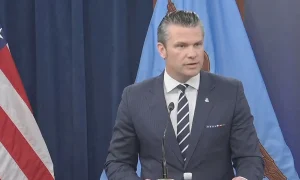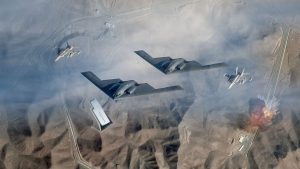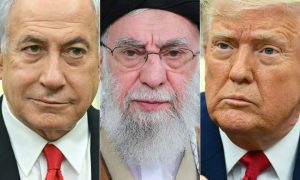Washington D.C. – The United States has executed one of its most significant military operations in decades, targeting Iranian nuclear infrastructure in a coordinated assault that has reshaped Middle Eastern geopolitics. The US strikes Iran nuclear facilities operation, designated as “Operation Midnight Hammer,” represents a decisive escalation in America’s approach to countering Iran’s nuclear ambitions.
Operation Midnight Hammer: A Comprehensive Military Response
Defense Secretary Pete Hegseth announced that the US strikes Iran nuclear facilities were conducted following direct orders from President Donald Trump. The operation targeted three critical Iranian nuclear installations: Fordow, Natanz, and Isfahan, marking the most substantial American military action against Iranian nuclear infrastructure in recent history.

Speaking at a Pentagon press conference, Hegseth emphasized that the US strikes Iran nuclear facilities demonstrated “bold and brilliant” strategic planning. The Defense Secretary declared the mission “an incredible and overwhelming success,” highlighting the precision and effectiveness of the coordinated assault.
The operation’s codename, “Operation Midnight Hammer,” reflects both the timing and the devastating impact of the strikes. The US strikes Iran nuclear facilities were executed with surgical precision, utilizing advanced military technology and strategic deception to achieve maximum effectiveness while minimizing collateral damage.
To get latest updates on The Iran-Israel War, keep a check on Channel6Network by clicking on the given link.
Strategic Targeting of Iranian Nuclear Infrastructure
The US strikes Iran nuclear facilities specifically focused on three primary locations that form the backbone of Iran’s nuclear program. Fordow, buried deep within a mountain, represents one of Iran’s most protected nuclear sites. This underground facility has long been considered virtually impregnable, making it a prime target for demonstrating American military capabilities.


Natanz, another crucial component of Iran’s nuclear infrastructure, has been central to the country’s uranium enrichment activities. The US strikes Iran nuclear facilities at Natanz aimed to significantly disrupt Iran’s ability to continue its nuclear development programs.
Isfahan, the third target in the US strikes Iran nuclear facilities operation, houses important nuclear research and development facilities. By targeting these three locations simultaneously, the United States sent a clear message about its commitment to preventing Iranian nuclear weapons development.
Military Precision and Advanced Weaponry
Air Force General Dan Caine, Chairman of the Joint Chiefs of Staff, provided detailed information about the military assets deployed during the US strikes Iran nuclear facilities operation. The mission utilized 75 precision-guided munitions, demonstrating the scale and intensity of the assault.


Among the weapons employed were 14 massive 13,000-pound GBU-57 “bunker buster” bombs, specifically designed to penetrate heavily fortified underground installations like Fordow. These specialized weapons were crucial to the success of the US strikes Iran nuclear facilities, particularly given the deep underground nature of many Iranian nuclear sites.


The operation also employed submarine-launched Tomahawk missiles, which struck their targets at approximately 2:00 AM local Iranian time. The US strikes Iran nuclear facilities were timed to maximize surprise and minimize the potential for Iranian defensive responses.
Tactical Execution and Iranian Response
General Caine confirmed that the US strikes Iran nuclear facilities encountered no Iranian opposition during the mission. Iranian surface-to-air weapons systems failed to detect the approaching American bombers, highlighting the sophisticated stealth capabilities employed during the operation.


The use of decoys and deception tactics proved highly effective, with no shots fired at the US strike package during the US strikes Iran nuclear facilities mission. This tactical success demonstrates the advanced planning and execution capabilities of American military forces.
Initial battle damage assessments indicate that all three targeted sites sustained “extremely severe damage and destruction” from the US strikes Iran nuclear facilities operation. However, officials noted that comprehensive damage assessments would require additional time to complete fully.
Strategic Objectives and Policy Implications


Defense Secretary Hegseth explicitly stated that the US strikes Iran nuclear facilities were not intended as regime change operations. Instead, the mission focused specifically on degrading Iran’s nuclear capabilities while avoiding broader military escalation.
The US strikes Iran nuclear facilities operation targeted only nuclear infrastructure, deliberately avoiding Iranian military personnel and civilian populations. This precision approach reflects American efforts to minimize humanitarian concerns while achieving strategic objectives.
President Trump’s decision to authorize the US strikes Iran nuclear facilities represents a significant shift in American foreign policy toward Iran. The operation demonstrates renewed American willingness to use military force to prevent nuclear proliferation in the Middle East.
International Reactions and Diplomatic Implications
The US strikes Iran nuclear facilities have generated significant international attention and concern. The UN Security Council has convened emergency sessions to address the situation, with Russia and China reportedly pushing for ceasefire negotiations.
Various lawmakers have responded to the US strikes Iran nuclear facilities with mixed reactions. Some have supported the decisive action, while others have raised concerns about potential escalation and congressional authorization requirements.
Iranian officials have acknowledged the US strikes Iran nuclear facilities but have downplayed their impact, claiming the nation did not suffer major damage. However, independent assessments suggest the strikes achieved their intended objectives.
Military Coordination and Multi-Domain Operations
The success of the US strikes Iran nuclear facilities required unprecedented coordination across multiple military domains. General Caine praised the exceptional collaboration between space, cyber, and naval forces during the operation.
This multi-domain approach to the US strikes Iran nuclear facilities demonstrates the evolution of modern warfare and America’s integrated military capabilities. The operation showcased how different military branches can work together to achieve complex strategic objectives.
Final Words: Deterrence and Future Implications
The US strikes Iran nuclear facilities operation marks a pivotal moment in Middle Eastern geopolitics and nuclear non-proliferation efforts. Defense Secretary Hegseth’s assertion that “American deterrence is back” reflects the broader strategic message behind Operation Midnight Hammer.
As the international community processes the implications of the US strikes Iran nuclear facilities, questions remain about Iran’s response and the potential for further escalation. The success of Operation Midnight Hammer has demonstrated American military capabilities while raising important questions about the future of diplomatic engagement with Iran.

